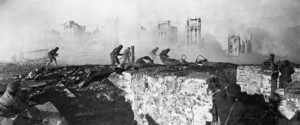
As we reach the end of January and a band of snow moves across Britain, it brings to mind the privations of troops who were caught up in one of the most awful campaigns of the Second War, resulting in the deaths of up to a million or more troops in the depths of a Soviet winter. The event was the assault on Stalingrad and the eventual encirclement and destruction of the German 6th Army which surrendered piecemeal in the second half of January 1943.
Stalingrad was one of three major Soviet cities that managed to avoid being completely captured (the others being Moscow and Leningrad), but its name cast a particular spell over Hitler who believed that its fall would cause such a shock to the Soviet Leader that it might even precipitate an end to the war in the east. It was also critical to protect the flanks of the effort to gain the oil fields in the Caucuses – a resource that Germany desperately needed to augment the smaller Romanian oilfields, its only other source of oil.
The drive on Stalingrad began in the late summer of 1942, but as the German 6th Army approached the city, it encountered stiffening resistance from Soviet forces that had learned a great deal from their disastrous experiences in the early days of Operation Barbarossa – the German invasion of Russia. Belts of prepared defences, mobile troops and airpower had taken their toll.
By the time the Germans had reached the outskirts of Stalingrad, a city 5km deep and stretched out over 25km along the western bank of the River Volga, their forces were already in a bad way, with manpower shortages due to combat losses, equipment reliability problems, logistics difficulties and facing increasing attacks from the Soviet air-force – particularly at night.
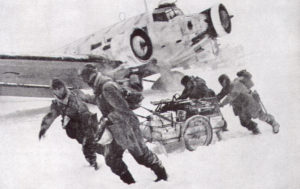
Sensing that the Germans had reached something of a standstill on the flanks to the north and south of Stalingrad, the Russians launched Operation Uranus, their own counter-offensive, on 19th November and broke through in areas that were held either relatively thinly, or in the northern sector by Axis troops including the Romanians and Italians, and encircled the German 6th Army and elements of the 4th Panzer Corps.
From November till their surrender, the German Army struggled to secure the perimeter of what became known as the Stalingrad Cauldron, a lozenge-shaped area stretching out to the west of Stalingrad and about 50km across. Initial expectations of a breakthrough by German armoured troops further to the east became increasingly unlikely as the weather turned cold and snow started to hamper movement. Promises that the Luftwaffe could resupply the trapped forces came to very little – although individual aircrews risked their lives on a daily basis to get supplies through.
Conditions in the Cauldron steadily deteriorated, partly as a result of the Germans losing control of their advanced airfields at the western end of the Cauldron. Attempts to break through to relieve the 6th Army had to be halted in order to stabilise the main German line, which was eventually pushed back some 300km to the west.
By late January 1943, hundreds of German soldiers were dying each day of cold, exacerbated by malnutrition, disease and untreated wounds. In the end, of the 300,000-plus troops initially trapped in the Cauldron, just over 100,000 were marched into captivity. Of those, records indicate that only about 6,000 made it back to Germany, some not returning until the mid-1950s. It is possible that some were never released.
The story will be familiar to many, but there have been some interesting new accounts of the Stalingrad Campaign that cast a slightly different light on the whole tragic saga. Based on new material made available in Russia, researchers have been able to get new insights into the experiences of both German soldiers captured at Stalingrad, as well as personal accounts of Russian soldiers of all ranks and civilians near the fighting, which were recorded both during and after the siege.
When the Russians accounts were collected, the communist authorities of the time decided they were a great deal too honest! Some very straight-forward and revealing comments did not make for good propaganda and so the records were hidden away, only to be released quite recently. Some of the celebrated Russian snipers, for example, felt great remorse about killing so many human beings, regardless of what the German Army had done to their country. (There is in fact still a lot more material held by the Russian MOD which might not see the light of day for some time to come.)
The Russian viewpoint is the theme of Jochen Hellbeck’s’s book; “Stalingrad, the city that defeated the Third Reich “, published by Public Affairs Books, New York. From the outset, the author makes it clear that he wants to correct an historical bias in favour of the Germans in the city after they were surrounded and facing a winter for which they were horribly unprepared in the main.
Hellbeck points out that the Germans were the aggressors and that not only did they lay waste vast areas of the Ukraine in their advance, but that they committed terrible atrocities which the Russians sought to avenge as they closed in on the Cauldron. He also observes that many more Russian soldiers were killed or wounded than Germans; some estimates put it as high as one million. Many more Russian troops were captured in the lead up to the battle and many of these were summarily executed after being “liberated” by their countrymen.
Hellbeck points a finger or two at established authors on the subject, including Anthony Beevor, who, according the Hellbeck, might have seen the new material but have tended to disregard it as being an “inconvenient truth”. He points out that the records show Russian soldiers wanting to fight, not because of the commissar with a pistol ordering him to do so, but because of a hatred of the invaders that inspired him to go to almost any length to kill them.
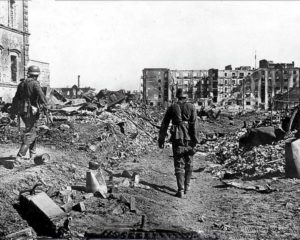
In another translation of a German book, Reinhold Busch presents series of true accounts of the battle written by German soldiers and airmen who survived. In some cases they got out before the Russians completed the encirclement, while others were extracted by air afterwards. Far more were driven into captivity in marches that claimed the lives of tens of thousands through cold and roadside executions. The stories are harrowing and, for former servicemen and women, tragic in the extreme. Decisions were made that now seem simply daft – but which meant that individual soldiers were forced to accept a growing sense of utter helplessness and doom.
The point about these individual accounts is that they emphasise the powerlessness of the individual to affect the fate beyond a very small degree. If you were called up you went from being a baker to a gunner in a matter of a few weeks – and then you were on your way to the Eastern front. Once there, you had no choice about whether you fought or not; you did what you had to do to survive the weather and an enemy equally determined to see their country free again. The book, “Survivors of Stalingrad, eyewitness accounts from the Sixth Army, 1942 – 43” is published by Frontline books.
The third book on the topic is a remarkable novel written by a communications officer, Heinrich Gerlach, who served in the 14th Panzer Division as it advanced to the Don and then retreated into the area of the Stalingrad Cauldron as the Romanian frontline collapsed. The story of the book is itself remarkable as Gerlach wrote it in captivity in Russia soon after the battle. However, the manuscript was confiscated and he gave it up for lost after returning from captivity. He then went through hypnosis to recall the events and re-wrote the novel in 1957, at which point it was published. However, after he died, the original manuscript was discovered in a Russian archive in 2012, and re-published in 2016. It was translated into English in 2018, and is titled “Breakout at Stalingrad” and published by Head Zeus.
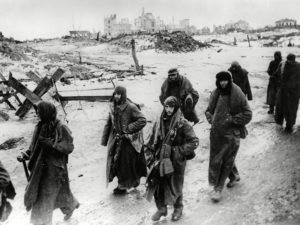
Gerlach wanted to describe as many of the events leading up to the surrender as he could, all of which were based upon his own experiences or those of people he served with or who were incarcerated with him. His main character is a young officer, Breuer, who is obviously based on Gerlach himself. However, he tells the stories of a number of characters who come and go within the overall saga and whose experiences allow him to tell the truth about Stalingrad from the point of view of those at the “bottom of the heap” in many cases.
As with “Survivors of Stalingrad”, there are parts of the book that make you want to walk away out of a sense of complete horror at what they went through. It makes one doubt whether people in the West today could put up with the combined tortures of cold, starvation and terrible injuries that they suffered. His graphic accounts of action and the aftermath are all based upon real events and borne out by the individual stories in “Survivors of Stalingrad”.
And so we come full circle to the Russian experiences of that campaign. Although better prepared for the worst that the weather could throw at them, and often better fed and equipped, they still suffered horribly out on the Steppes as they assaulted the German positions, driving them back into the Cauldron. However, as is so often the case, once a soldier had laid down his arms, his immediate captors frequently treated him with kindness, knowing that they were suffering the same cold and battle-weariness. The same cannot be said for the rear-echelon troops who led them away to the camps in the east (although many did eventually reach a sensible relationship with their prison guards).
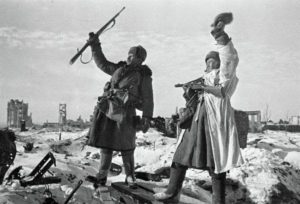
The books are all excellent and, as a trio, bring to life some of the more established and formal accounts of the battle for Stalingrad, 1942-43.

Comments on The Stalingrad Cauldron 1942/43